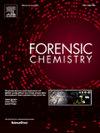Electron ionization fragmentation studies of ethoxy and methoxymethyl substituted phenylacetones
IF 2.2
3区 医学
Q2 CHEMISTRY, ANALYTICAL
引用次数: 0
Abstract
The EI mass spectral fragmentation pathways and products were compared for substituted benzaldehydes and phenylacetones containing ethoxy and methoxymethyl substituents. The methoxymethylbenzene group is the only ether regioisomeric possibility with the ethoxybenzene group (and each have an isobaric relationship with the methylenedioxybenzene group) and are substituted in all three aromatic ring positions relative to the aldehyde and acetone moieties. The phenylacetones were synthesized from the corresponding precursor benzaldehydes. Stable isotope deuterium labeling in the ether substituents as well as product ion spectra and accurate mass time-of-flight analysis confirmed the structure of major fragments and allowed for prediction of the mechanisms of formation.
The methoxymethylbenzaldehydes yield a major fragment at m/z 135 via loss of the methyl radical. The ethoxy substituted isomers however have a base peak at m/z 121 via rearrangement loss of ethene followed by elimination of the aldehyde hydrogen radical. The EI mass spectra of ethoxyphenylacetones show the major ethoxybenzyl cation at m/z 135 via loss of the acetyl radical and the m/z 107 cation via elimination of ethene from the ethoxybenzyl cation. The EI mass spectra of methoxymethylphenylacetones are dominated by the radical cation at m/z 104 [C8H8]+•. Unique meta- specific radical cations at m/z 136 and m/z 108 were observed in 3-ethoxyphenylacetone. An ortho effect in methoxymethylphenylacetones yielded the unique fragments at m/z 121, m/z 146 and m/z 145. The results of this study identify m/z 107 and m/z 104 as unique marker ions for the differentiation of the regioisomeric ethoxy and methoxymethyl substituted phenylacetones.

乙氧基和甲氧基甲基取代苯丙酮的电子电离破碎研究
比较了含乙氧基和甲氧基取代基的苯甲醛和苯丙酮的EI质谱裂解途径和产物。甲氧基甲苯是唯一可能与乙氧基形成乙醚区域异构体的基团(两者都与亚二氧基有等重关系),并且在相对于醛和丙酮的三个芳香环位置上都被取代。苯丙酮是由相应的前体苯甲醛合成的。稳定同位素氘在醚取代基上的标记以及产物离子谱和精确的质量飞行时间分析证实了主要碎片的结构,并允许预测形成机制。甲氧基甲基苯甲醛通过甲基自由基的损失在m/z 135处产生一个主要片段。然而,乙氧基取代异构体在m/z 121处有一个碱基峰,这是由于乙烯的重排损失,然后是醛氢自由基的消除。乙氧基苯丙酮的EI质谱表明,在m/z 135处,乙氧基苯基阳离子因乙酰自由基的损失而形成;在m/z 107处,乙氧基苯基阳离子因乙烯的消除而形成。甲氧基甲基苯丙酮的EI质谱以m/z 104 [C8H8]+•自由基阳离子为主。在3-乙氧基苯丙酮中观察到m/z 136和m/z 108特异的自由基阳离子。甲氧基甲基苯丙酮的邻位效应在m/z 121, m/z 146和m/z 145处产生了独特的片段。本研究鉴定m/ z107和m/ z104是区分区域异构体乙氧基和甲氧基甲基取代苯丙酮的唯一标记离子。
本文章由计算机程序翻译,如有差异,请以英文原文为准。
求助全文
约1分钟内获得全文
求助全文
来源期刊

Forensic Chemistry
CHEMISTRY, ANALYTICAL-
CiteScore
5.70
自引率
14.80%
发文量
65
审稿时长
46 days
期刊介绍:
Forensic Chemistry publishes high quality manuscripts focusing on the theory, research and application of any chemical science to forensic analysis. The scope of the journal includes fundamental advancements that result in a better understanding of the evidentiary significance derived from the physical and chemical analysis of materials. The scope of Forensic Chemistry will also include the application and or development of any molecular and atomic spectrochemical technique, electrochemical techniques, sensors, surface characterization techniques, mass spectrometry, nuclear magnetic resonance, chemometrics and statistics, and separation sciences (e.g. chromatography) that provide insight into the forensic analysis of materials. Evidential topics of interest to the journal include, but are not limited to, fingerprint analysis, drug analysis, ignitable liquid residue analysis, explosives detection and analysis, the characterization and comparison of trace evidence (glass, fibers, paints and polymers, tapes, soils and other materials), ink and paper analysis, gunshot residue analysis, synthetic pathways for drugs, toxicology and the analysis and chemistry associated with the components of fingermarks. The journal is particularly interested in receiving manuscripts that report advances in the forensic interpretation of chemical evidence. Technology Readiness Level: When submitting an article to Forensic Chemistry, all authors will be asked to self-assign a Technology Readiness Level (TRL) to their article. The purpose of the TRL system is to help readers understand the level of maturity of an idea or method, to help track the evolution of readiness of a given technique or method, and to help filter published articles by the expected ease of implementation in an operation setting within a crime lab.
 求助内容:
求助内容: 应助结果提醒方式:
应助结果提醒方式:


